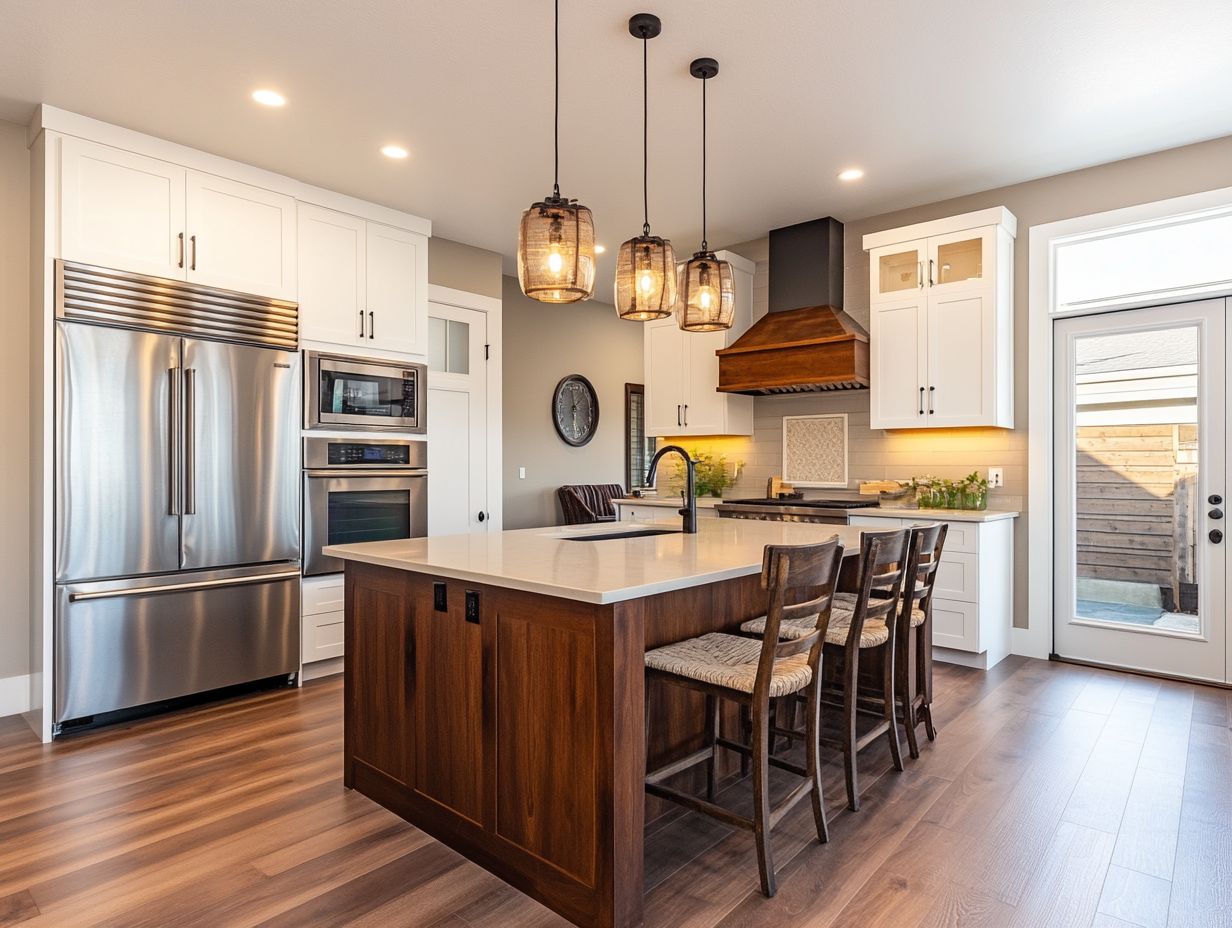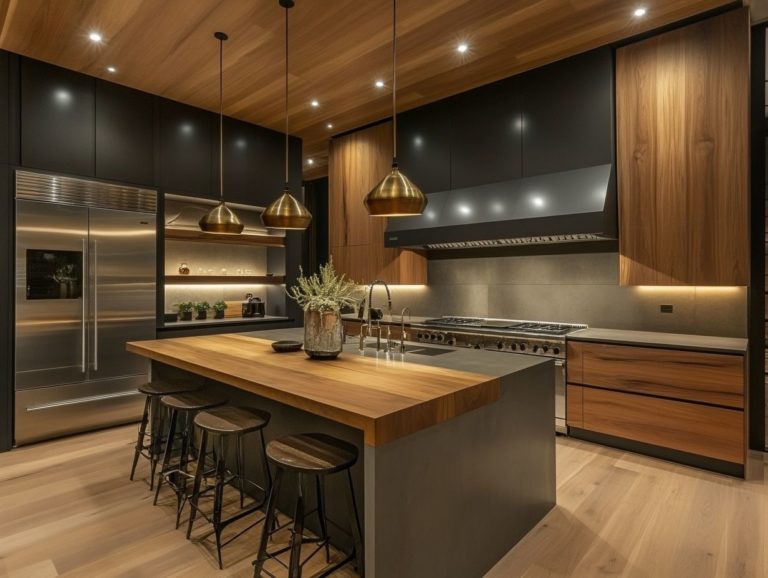5 Smart Kitchen Lighting Ideas for Saving Energy
Transforming your kitchen into an energy-efficient haven can be surprisingly simple. Get ready to light up your kitchen and save energy!
Consider these five innovative lighting strategies that will brighten your space and help you cut energy costs.
From installing light-emitting diodes (LEDs) to harnessing the power of natural light, each tip provides practical solutions for creating a more sustainable kitchen.
You’ll also want to explore the advantages of smart lighting systems and task lighting, ensuring your culinary experiences are vibrant and eco-friendly.
Contents
- Key Takeaways:
- 1. Install LED Lights
- 2. Use Motion Sensor Lights
- 3. Utilize Natural Light
- 4. Invest in Smart Lighting Systems
- 5. Use Task Lighting
- How Can Smart Lighting Help Save Energy?
- What Are the Different Types of Smart Lighting Systems Available?
- How Are Motion Sensor Lights Beneficial in the Kitchen?
- What Are the Best Ways to Utilize Natural Light in the Kitchen?
- How Can Task Lighting Improve Energy Efficiency in the Kitchen?
- What Are Some Other Tips for Saving Energy in the Kitchen?
- Frequently Asked Questions
- What are some smart kitchen lighting ideas for saving energy?
- How can LED lights save energy in the kitchen?
- What are the benefits of utilizing natural light in the kitchen?
- Why is task lighting a smart choice for saving energy in the kitchen?
- How do dimmer switches contribute to energy savings in the kitchen?
- Are motion sensor lights a good choice for energy efficiency in the kitchen?
Key Takeaways:

Switching to LED lights can cut energy costs and save you money. Motion sensor lights automatically turn off when not in use, preventing wasted energy. Utilizing natural light through windows or skylights brightens up the kitchen without using electricity.
1. Install LED Lights
Installing LED lights is a transformative step towards energy efficiency and eco-friendly lighting in your home. Premium brands like Philips Hue and LIFX offer solutions that significantly reduce energy consumption compared to traditional incandescent bulbs.
These LED options can last up to 25 times longer than incandescent bulbs, resulting in fewer replacements and less waste. Their lower heat emission helps maintain a cooler indoor atmosphere, which can also lower your air conditioning costs.
Philips Hue allows you to customize your lighting through smart home integration, letting you personalize moods via smartphone apps. Meanwhile, LIFX provides vibrant color options that inspire creativity in your lighting design.
Together, these products elevate your modern living spaces and promote a greener lifestyle.
2. Use Motion Sensor Lights
Incorporating motion sensor lights boosts security and optimizes energy usage. These intelligent systems automatically turn off lights when a room is unoccupied, leading to energy savings and improved occupancy awareness.
These sensors work best in high-traffic areas, like kitchens, activating lights only when needed. By effectively using motion sensors, you can complement energy-efficient appliances, creating an environment that minimizes waste and lowers electricity bills.
Integrating these systems with existing energy-efficient devices streamlines operations, making daily activities more convenient and cost-effective. This blend of modern technology and energy management contributes to a greener lifestyle and enhances safety features.
3. Utilize Natural Light
Effectively harnessing natural light in your kitchen can significantly lower energy consumption while creating a warm, inviting atmosphere. Thoughtful architectural elements—like larger windows and strategically placed skylights—enhance the flow of daylight into your space.
Daylight harvesting techniques, which use sensors and reflective materials to maximize existing light, elevate the ambiance while reducing reliance on artificial lighting.
This intentional use of natural light cultivates a cheerful and productive kitchen, supporting your energy efficiency goals and leading to lower utility bills.
By applying these tips, you can transform your kitchen lighting while saving energy and money!
4. Invest in Smart Lighting Systems

Investing in smart lighting systems transforms your home automation experience by using voice-controlled lights that provide unmatched convenience. They also offer features that monitor energy use.
This helps you gain valuable insights into your energy consumption, allowing for effective optimization. You can control your lighting easily with simple voice commands through platforms like Amazon Alexa and Google Home.
You can adjust the ambiance with minimal effort. With options like smart dimmers and color-changing LED bulbs, you elevate the aesthetic appeal of your spaces while significantly reducing energy use.
Scheduling lights to turn off when they’re not in use or dimming them during daylight promotes a sustainable lifestyle and lowers your electricity bills.
Ultimately, integrating smart lighting technology enhances not just your convenience but also your commitment to energy efficiency and environmental responsibility.
5. Use Task Lighting
Incorporating task lighting—like sleek LED pendant lights and elegant decorative wall lights—into your kitchen design offers focused illumination, greatly enhancing functionality and energy efficiency.
With dimmer switches and modern LED technologies, you can achieve the perfect balance. This targeted lighting is crucial in areas dedicated to meal preparation and cooking, ensuring surfaces are well-lit and minimizing accidents.
Whether you’re chopping vegetables or following a recipe, having the right amount of light transforms your experience. Adding dimmer switches gives you the flexibility to adjust brightness according to the time of day or your desired ambiance, allowing for energy savings and a cozy atmosphere.
Meticulously designed task lighting can enhance both the aesthetics and usability of your kitchen, making it not just a cooking space but a hub of creativity and comfort.
How Can Smart Lighting Help Save Energy?
Smart lighting systems are essential for energy savings, leveraging automation features that adjust lighting based on occupancy, time of day, and your preferences. This can lead to significant reductions in overall energy consumption.
These systems detect when a room is empty and automatically turn off the lights, eliminating the need for manual intervention. They can also be programmed to dim or brighten in response to natural sunlight, optimizing your comfort and efficiency.
For homeowners focused on enhancing energy efficiency, monitoring energy use is vital. By tracking usage patterns, you can identify which areas consume the most power and adjust your habits accordingly.
You might also consider integrating smart lighting with other energy-saving devices for a comprehensive approach to home energy management.
What Are the Different Types of Smart Lighting Systems Available?
The market for smart lighting systems offers a remarkable variety of choices, from voice-controlled lights to sophisticated smart switches, all designed to elevate your home automation and efficiency.
With customizable settings at your fingertips, you can easily adjust color temperatures and brightness levels to match your mood or the occasion. Imagine your lighting harmonizing with energy-efficient appliances, creating a cohesive smart home environment where your lighting syncs with HVAC systems or smart thermostats.
Picture your living room lights dimming automatically when the smart thermostat senses a rise in temperature! Or waking gently to soft illumination at sunrise? This seamless interconnectivity leads to significant energy savings and enhances your daily convenience, turning routine moments into enjoyable experiences that elevate your lifestyle.
How Are Motion Sensor Lights Beneficial in the Kitchen?

Motion sensor lights bring exceptional advantages to your kitchen, enhancing both safety and convenience. They also promote energy savings.
By detecting occupancy, they automatically adjust the lighting based on your presence. This makes your kitchen experience smoother.
These innovative lighting solutions use infrared sensors or microwave technology to recognize movement. They ensure that the lights illuminate only when necessary.
In the lively atmosphere of a kitchen, this feature is especially beneficial. It frees you from the hassle of searching for switches while juggling grocery bags or cooking utensils.
These lights turn off automatically when no one is in the area. This significantly reduces energy consumption.
This can lead to exciting savings on your utility bills and minimizes your environmental footprint. Their versatility allows for optimal placement in spots like pantries or under cabinets, creating a well-lit space that enhances both efficiency and safety.
What Are the Best Ways to Utilize Natural Light in the Kitchen?
Utilizing natural light in your kitchen by using natural light effectively lessens your reliance on artificial lighting. It also cultivates a vibrant and inviting atmosphere that aligns seamlessly with eco-friendly lighting practices.
To achieve this, prioritize thoughtful window placement. Position large windows to capture the maximum amount of sunlight during peak hours.
Incorporating reflective surfaces, like light-colored countertops and strategically placed mirrors, can amplify incoming light. This makes your space feel brighter and more expansive.
Architectural choices like skylights or clerestory windows can enhance light flow. This ensures that every corner of your kitchen is beautifully illuminated.
By adopting these strategies, you’ll enjoy a more cheerful kitchen environment. You will also contribute to lower energy bills and a reduced carbon footprint.
How Can Task Lighting Improve Energy Efficiency in the Kitchen?
Implementing task lighting, like LED pendant lights, in your kitchen can dramatically boost energy efficiency. It delivers focused illumination exactly where you need it.
This allows you to have better control over lighting levels, especially with the addition of dimmer switches. This targeted approach enhances visibility while you cook or prepare meals.
Task lighting beautifully complements the ambient light already in your space. Strategically placed task lighting in reading nooks or home offices can foster an environment that promotes concentration and productivity.
By incorporating dimmer switches with these specific light sources, you can easily adjust brightness to suit your needs and moods. This leads to even greater energy savings.
The intentional layering of different types of lighting amplifies their effectiveness. It also creates a more comfortable and versatile living area.
What Are Some Other Tips for Saving Energy in the Kitchen?
Along with exploring smart and natural lighting solutions, incorporating various energy-saving tips in your kitchen fosters a more sustainable environment.
Consider investing in energy-efficient appliances and adopting mindful energy consumption practices. This approach cuts down on your electricity bills and aligns you with a broader movement towards environmental stewardship.
For instance, when you’re cooking, choosing smaller appliances like slow cookers or microwaves can significantly reduce energy use compared to a conventional oven. Using lids on pots enhances cooking efficiency, saving you both time and energy.
Swapping out incandescent bulbs for LED lighting creates an immediate impact. LEDs consume much less energy and have a longer lifespan, helping to reduce waste.
These small changes contribute to a greener kitchen and promote an eco-friendly lifestyle that ultimately benefits everyone.
Frequently Asked Questions

What are some smart kitchen lighting ideas for saving energy?
1. Install LED lights. They save energy and last much longer than regular bulbs.
2. Utilize natural light. Open your windows to brighten your kitchen during the day.
3. Use task lighting. Focus lights on specific areas where you need them instead of lighting the whole kitchen.
4. Invest in dimmer switches. They let you adjust brightness and save energy when you don’t need full light.
5. Install motion sensor lights. These lights turn off automatically when not in use, saving you money on your electricity bill.
How can LED lights save energy in the kitchen?
LED lights use much less energy than regular bulbs. They last longer, meaning you won’t have to replace them as often.
What are the benefits of utilizing natural light in the kitchen?
Natural light brightens your kitchen and saves energy. It also helps improve your mood and reduces eye strain.
Why is task lighting a smart choice for saving energy in the kitchen?
Task lighting focuses light on the areas you need. This targeted approach means you’ll use less energy overall.
How do dimmer switches contribute to energy savings in the kitchen?
Dimmer switches let you adjust your lights’ brightness. This flexibility can lead to significant energy savings over time.
Are motion sensor lights a good choice for energy efficiency in the kitchen?
Yes! Motion sensor lights automatically turn off when no one is around. They help prevent waste and are perfect for forgetful moments.





